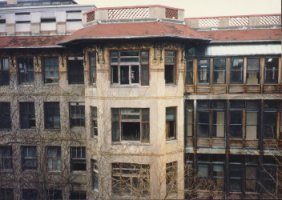Preservation Alert:
|
||||
|
Seaview Hospital-Farm Colony Historic District was designated an official New York City Landmark in 1985. Today, most of the building on this property remain vacant and many are in a severe state of deterioration. Demolition by neglect is an unacceptable fate for New York's landmark buildings. |
||||
 |
The Friends of Terra Cotta is particularly concerned about the exacerbated condition of the ceramic murals and ornament which surround the tops of the Women's Ward Pavilions, buildings #1 - #4. These remarkable works were produced in Delft, Holland by De Porceleyne Fles (later owned by Joost Thooft & Labouchere), the only remaining manufacturer of Delftware which has been in continuous operation since 1672. Numerous tile experts have been interested in seeing these and they will be featured in an upcoming publication by Hans Van Lemmen. After a visit in late February 1998, during which some of these horrendous conditions were documented, it is clear that we must make the city take appropriate action. |
 Photos by David Jones |
||
|
Seaview Hospital is situated today on 400 acres surrounded by residential property, a golf course, park and high school. |
||||
|
Eight buildings were erected in 1909-11, in Mission Revival Style, as men’s and women’s wards for tuberculosis patients. Until the 1920’s these buildings plus a powerhouse, staff house, surgical pavilion, an administration building and old nurses home made up the hospital. In 1972, four of the original eight ward buildings were demolished for a new infirmary. |
||||
|
Architect Raymond F. Almirall of New York City designed the buildings and the terra cotta ornament. The ceramic work was produced in Delft, Holland by the Joost Thooft & Labouchere Company. This company has been in continuous operation since the 1750s. The design is a brilliantly colored series of ceramic murals and reliefs with gold square tiles, garlands, crests and seashells. Almost life-size figures of children, nurses and physicians are repeated on each building. There are four distinct groups of figures along with a series of iconographic shields. |
 |
||
Go to: The Significance of Seaview Hospital and the surrounding Historic District --Excerpted from the NYC Landmarks Designation Report -- Designation Date: March 26, 1985BACKGROUND INFORMATION on the Women's Ward Pavilions --(Excerpted from a 1989 report by architect Tom Hilmer for the Art Commission: Conservation of the Terra Cotta Friezes in the 1910 Women's Ward Pavilions, Buildings #1-4.)See Letter from Bart Verbrugge, Rijswijk, Netherlands, concerning the significance of these buildings.See Delft Holland Ceramicist Visits Seaview HospitalReturn to Friends of Terra Cotta Home Page |
|||